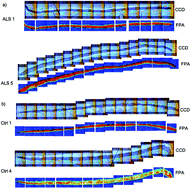Diagnosis of idiopathic amyotrophic lateral sclerosis using Fourier-transform infrared spectroscopic analysis of patient-derived skin†
Abstract
One of the great challenges in identifying effective therapy in many neurodegenerative diseases, such as amyotrophic lateral sclerosis (ALS), is the lack of reliable biomarkers. In this study, we applied infrared imaging microspectroscopy, a valuable technique to investigate biomolecule fingerprints and secondary structure of proteins within biological tissue. We hypothesized that, since skin and CNS have the same embryonic origin, spectral differences associated with ALS-specific pathological events will be readily detectable through skin testing using this technique. Cells from healthy individuals and ALS patients were isolated from skin biopsies in order to generate tissue-engineered in vitro skin (TES). Infrared spectra of the generated TES were recorded using a focal-plane-array Fourier transform infrared (FPA-FTIR) spectrometer, and hierarchical cluster analysis of the spectral data was performed in order to establish clear differences between the tested TES specimens. Interestingly, our analyses showed that it was readily possible to discriminate ALS- and control-TES solely based on differences in associated FTIR spectra, mainly located between 1149 and 1473 cm−1, attributed to disruption of phospholipid cell membranes, extracellular matrix remodeling or cholesterol accumulation. Spectral differences within the TES samples may therefore be associated with disease state, paving the way for the identification of biomarkers in ALS.



 Please wait while we load your content...
Please wait while we load your content...